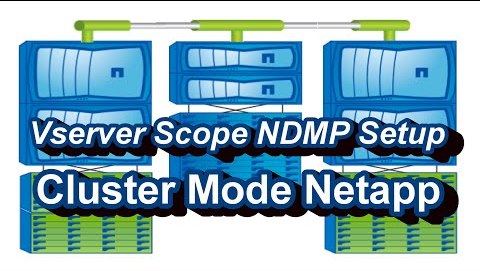Today we will see, How to enable vserver scope NDMP in the NetApp cluster mode. Note that if the backup application is Cluster Aware Backup then we can enable Vserver-scope NDMP, else we need to use Node-Scope-NDMP Configuration.

What Is Vserver Scope NDMP?
Vserver scope NDMP concept started after Data Ontap 8. With this feature, the backup can be taken at the SVM level or at the entire cluster level. You can take all volumes backup with a single NDMP user and LIFs.
Steps To Enable Vserver Scope NDMP
To enable vserver scope NDMP first we need to create an NDMP user. It’s easy to create a single NDMP user on the cluster vserver. We can use this user to take the backup of all volumes.
You can watch below YouTube Video for the detail process to enable the NDMP at the SVM level.
Step 1. Confirm that node-scope-mode is disabled
In the NetApp cluster, you can only enable one type of NDMP. If node scoped NDMP is disabled state then by default vserver scope NDMP will be in the enabled state.
::> system services ndmp node-scope-mode status
NDMP node-scope-mode is disabled.
Step 2. Disable Node Scoped Mode NDMP
If you see that the NDMP scope is enabled then just disable it. Once you disable it by default vserver-scope NDMP will be on automatically. There is no separate command to enable SVM-scope NDMP.
::> system services ndmp node-scope-mode off
NDMP node-scope-mode is disabled.
Step 3. Verify that the NDMP protocol is allowed on all Vserver
Now you need to verify if NDMP protocol is in the allowed-protocol list of all SVM. If it there then fine else you must add it to SVM.
Execute the below command to see all protocols that are allowed on SVM.
:>vserver show -vserver vs_cifs -fields allowed-protocols vserver allowed-protocols
------- -----------------------
vs_cifs nfs,cifs,fcp,iscsi
If you do not see NDMP Protocol in the list, then add it to SVM. Make sure that you do not remove any existing protocol. In the command, you should mention NDMP along with existing protocols.
::> vserver modify -vserver vs_cifs -allowed-protocols nfs,cifs,fcp,iscsi,ndmp
Step 4. Enable Vserver Scope NDMP
Now you need to enable the NDMP on all vserver. You can also enable NDMP for cluster SVM that can manage all vserver in the NetApp cluster.
If you need to take backup for particular SVMs then enable SVM scope NDMP at SVM level.
::> vserver ndmpd on -vserver vs_cifs
Step 5. Verify vserver scope NDMP status
Now you can again verify the NDMP status of the NetApp cluster.
::> vserver ndmpd show VServer Enabled Authentication type
------------- --------- -------------------
cifs false challenge
cm2220a-cn false challenge
dd false challenge
svm_cifs false challenge
svm_nfs false challenge
vs_cifs true challenge
vsarun false challenge
7 entries were displayed.
Step 6. Set Up Authentication For Vserver Scope NDMP
The next step is to set up authentication for a backup tool. When using NDMP in the ‘SVM-Scope’ mode, you can set up authentication in Vserver or Cluster level.
This means you can create a single cluster-wide NDMP user in cluster vserver that can manage all of the SVMs in the entire cluster. On the other hand, you can create separate NDMP users for each SVM.
You can also use the default cluster user account “admin” as well. You just have to generate a password for admin.
Execute the below command to generate the NDMP password for the entire cluster.
cluster::> vserver services ndmp generate-password -vserver cluster -user admin
Vserver: cluster
User: admin
Password: iF84X7B5A5HrboV
You can give this user name and password to your backup administrator. They will have to use this credential to back up volumes. Additionally, you have to give the cluster management LIF for backup.
Note that in your case the password may be different than the above. Don’t forget the subscribe notification for more such content.

